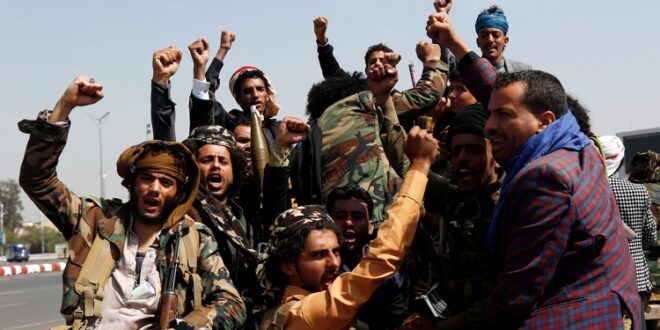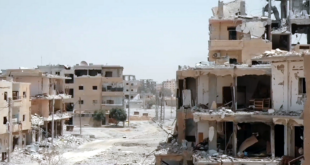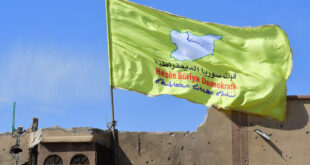The recent agreement to restore diplomatic relations between Saudi Arabia and Iran raised hope among Western leaders and some Yemen watchers that it could help bring an end to the war in Yemen, in which Tehran and Riyadh back opposing sides. Hans Grundberg, the U.N. special envoy for Yemen, who spent much of his time last year visiting Tehran, Riyadh, Abu Dhabi, and Muscat, asked Yemen’s leaders to “seize the opportunity presented by this regional and international momentum to take decisive steps towards a more peaceful future.” The international community, however, can do more harm than good if its actions are driven by hope and desperation rather than a careful reading of the reality on the ground. Yemen must not be a sacrificial lamb for improving relations between Iran and Saudi Arabia or viewed as an opportunity to revive the 2015 Iran nuclear deal. Instead, Yemen must be understood through its own internal dynamics and how they intertwine with those of regional actors.
March 26, 2023 marks eight years since the Saudi-led coalition (SLC) launched a military offensive to reverse the Houthis’ coup and reinstate then-President Abed Rabbo Mansour Hadi’s government to power in Sana’a. The Houthi rebels had captured the capital city in September 2014, putting an end to the political transition process and dragging the country into civil war. At the time, Saudi officials told the Obama administration that it would take them six weeks to restore the legitimate Yemeni government in Sana’a and end the Houthis’ coup. Eight years on, the Houthis have emerged as a strong military power while SLC-backed forces remain fragmented. Poor management and splits between the SLC’s members have played into the Houthis’ hands and, by association, those of their backer, Iran.
The Saudi-Houthi talks
The last few years saw a radical change in the Saudis’ approach in Yemen as the priority shifted from defeating the Houthis to securing their borders from Houthi attacks. Between 2015 and 2022, the Houthis carried out nearly 1,000 missile attacks and 350 drone strikes against key infrastructure, including oil facilities, airports, and military sites inside the kingdom. To find a way out of its costly quagmire in Yemen, Saudi Arabia scaled back its military intervention and stepped up its diplomatic efforts in a bid to de-escalate and find a political solution. The kingdom declared two unilateral cease-fires in 2020 and 2021 and further reduced its already inadequate military support to Yemeni government forces. Between 2019 and 2021, senior Saudi leaders, including King Salman bin Abdulaziz and then-Deputy Minister of Defense Khaled bin Salman, paid visits to Muscat to discuss ways in which Oman could help move toward a resolution of the conflict. In April 2022, the Saudis and the Houthis agreed to a cease-fire that lasted for six months, and in June of the same year the two sides resumed talks that excluded the Yemeni government.
Last year, the SLC re-engineered the power dynamics among its allies in Yemen to support its push for a peaceful resolution of the conflict. As a result of pressure by the SLC, former President Hadi handed over his authority to a Presidential Leadership Council (PLC), the eight members of which were handpicked by Saudi Arabia and the UAE. According to the presidential decree, the PLC is tasked with negotiating with the Houthis to achieve a permanent cease-fire and reach an inclusive and final political solution that includes a transition process to move Yemen from war to peace.
In contrast to other actors in Yemen, the Houthis have benefited from direct military support from Iran and Hezbollah in the form of weapons, training, and mentoring that helped build up their regular and irregular warfare capabilities. They have also capitalized on the SLC’s lack of strategy and inconsistencies as well as the anti-war advocacy campaign that put intense pressure on Western governments and the SLC to end the war. This materialized in the 2018 Stockholm Agreement, which forced the SLC to scale back its military support to the Yemeni government and allowed the Houthis to reposition their forces and make significant military gains, helping to strengthen their position in the Saudi and U.N. talks. As a result of last year’s truce, Saudi Arabia lifted restrictions on Hodeida port, allowing commercial and fuel ships to enter the port normally and bypassing the Yemeni government’s approval process.
The Houthis’ military gains have allowed them to dictate the path of international diplomacy in Yemen. They know Saudi Arabia is desperate to extricate itself and the international community wants the Yemen problem to go away. They do not recognize and refuse to negotiate with the PLC or other Yemeni factions that they cast as “Saudi mercenaries.” They view the war as one between them as the only true representatives of Yemen and the Saudis. But as Gregory Johnson argues, the Houthis “aren’t about to stop fighting their rivals in Yemen, no matter what deal the group signs with Saudi Arabia.” Indeed, even as the Houthis were making progress in talks with the Saudis, the rebel group continued to expand its recruitment, mobilization, and stockpiling of arms during last year’s truce as Iran significantly increased its weapons shipments. The group also carried out a series of attacks targeting key seaports and vital infrastructure in the south last October-December, which Ibrahim Jalal described as a “significant change in Houthi tactics towards the use of economic and remote warfare.” Just last week, the Houthis launched a major attack to capture Harib District southeast of Marib and attacked government forces in Shabwa. In February a Houthi-controlled court sentenced 30 Yemeni military commanders, including the minister of defense, to death, and on March 25, the minister survived a Houthi drone attack that targeted his convoy in Taiz Governorate, injuring and killing several of those escorting him. On March 23, the Houthis conducted a military drill close to the Saudi border to remind the Saudis of “the cost of no agreement and further concessions,” as Ibrahim Jalal noted.
Saudi-UAE tension in the south
While the Saudis are redefining their relations in the region by mending fences with Iran, a slow-burning proxy conflict has been brewing in southern Yemen between the Saudis and Emiratis. Since 2015, the UAE has expanded its sphere of influence in the south. The UAE formed an array of armed forces that have competed with the Yemeni government and that currently control Aden and most of the south. Additionally, it backs the Southern Transitional Council (STC), a political organization whose goal is the independence of the territory that constituted South Yemen prior to the 1990 unification with the north. For the UAE, the Yemen war offered an opportunity to secure influence in the Red Sea and Horn of Africa. Although it announced its withdrawal from Yemen in 2019, the UAE retains great influence through its local allies and proxy forces, which control Yemen’s rimland — the coast, islands, ports, and energy terminals. In 2021, reports revealed that the UAE is building an airbase on the strategic island of Mayun (Perim) in the Bab el-Mandeb Strait. The Saudis, who lacked a clear objective and failed to create strong allies on the ground, relied mainly on their political influence to shape events in the south, which proved largely ineffective.
The divergence of interests between the Saudis and Emiratis manifested in recurring cycles of violent conflict between their allies in Yemen. In August 2019, after a series of clashes, the UAE-backed STC and southern forces drove the Saudi-backed Yemeni government out of Aden city. Two months later, Saudi Arabia managed to broker the Riyadh Agreement between the Yemeni government and the STC to halt military confrontations, share power, and bring armed forces into the Yemeni government’s chain of command. It took over a year of negotiation and pressure by Saudi Arabia for the sides to agree to a coalition government and for the new cabinet to arrive in Aden — at which point a Houthi missile came close to annihilating as it landed at the airport.
Disagreements on the implementation of the Riyadh Agreement between the STC and the Yemeni government, particularly on bringing the armed forces under a unified command, led to increased hostility and sporadic fighting in the south. The formation of the PLC, which includes STC representation, did not help to mitigate the tension. During 2022, the STC and allied forces moved aggressively to consolidate their power in the south. By the summer of 2022, they took control of Shabwa and Abyan governorates, driving government forces out and defying orders by the president of the PLC, Rashad al-Alimi, to cease all military operations until units were redeployed in accordance with the Riyadh Agreement. The ongoing tension between the head of the PLC and STC leader AIdarous al-Zubaidi paralyzed the PLC, further undermining the anti-Houthi forces.
Alarmed by the STC’s moves to expand its control of the al-Wadi region of Hadhramaut, the Saudis stepped up their military and political engagement with Yemeni actors. Located in inland Hadhramaut, al-Wadi is home to Yemen’s largest oil reserves and is the last stronghold of the Yemeni government in the south. It shares a roughly 700-km border with Saudi Arabia, which makes it strategic for Saudi security interests. In January 2023, President Alimi officially formed the National Shield Forces (NSF), which reports directly to him. The force has seven brigades and 8,000 fighters. It is entirely funded by the Saudis and operates outside of the Yemeni government’s chain of command. Several brigades of the force were deployed to Hadhramaut to prevent the STC from seizing al-Wadi. More alarmingly, the Saudis and Emiratis have split their proxies along pre-1990 fault lines. The UAE-backed STC and allied forces are predominantly from the southern regions of Yafa’a and Dhale, while the Saudi-backed NSF hail mainly from Lahj and Abyan.1 A division along regional lines — Yafa’a and Dhale vs. Abyan and Lahj/Shabwa — is rooted in the power struggle in the former South Yemen (People’s Democratic Republic of Yemen) that led to a bloody civil war in 1986, a conflict that remains largely unresolved today.
Over the past several months, senior Saudi military officials have paid visits to Shabwa and Hadhramaut. In Riyadh, Saudi officials and Alimi met with military commanders from Shabwa who were forced out of their positions when the STC took control of the area last year. The Saudis also summoned the UAE-backed Shabwa governor and banned the STC leader from coming back to Aden several times, the most recent of which lasted for six months. In early March, Zubaidi and Abdulrahman al-Mahrami, members of the PLC who are backed by the UAE, did not show up for a meeting the PLC held with Saudi Crown Prince Mohammed bin Salman.
What’s next?
Eight years of military intervention by the SLC saw the war in Yemen evolve from a civil war into a battleground for proxy war among regional actors. Through the recent China-brokered Iran deal and by making concessions to the Houthis, Saudi Arabia seeks a quick and easy way out of the Yemen war, which has become an “unnecessary distraction” from its domestic development objectives under Vision 2030. The kingdom has all the leverage it needs to force the PLC, which is entirely dependent on the SLC, to accept a political settlement with the Houthis. The Houthis and Iran, which ran a successful military and information warfare campaign, might tactically de-escalate and even accept a political settlement to get the Saudis out of the way. Meanwhile, the divergence between the Saudis and Emiratis has left the anti-Houthi forces deeply fragmented and fueled tensions that have destabilized the south. This Saudi-UAE tension is likely to escalate, especially in light of the growing rift over economic and political influence in the region, and none of this is good news for Yemen. But Riyadh is building a 900-km fence to completely seal off its border with Yemen in case things get messy in the future.
What happens next is hard to predict, but a peace scenario does not seem to be on the horizon. The Houthis are likely to resume their military campaign to seize control of Yemen sooner or later. A scenario in which the Saudis ally with the Houthis to undermine UAE influence in the south is not outside of the realm of possibility. The deal with Iran and the talks with the Houthis might seem positive on paper from an international diplomacy perspective. In reality, however, Iran took advantage of Saudi fatigue in Yemen and focused more on building diplomatic and political support to help normalize the Houthis’ position within the international community. The Houthis are still part and parcel of Iran’s so-called “Axis of Resistance.” With the Houthis gaining international political recognition and the SLC out, Iran would have a greater chance to expand its influence in Yemen with the blessing of Western powers. The international community is eager for a “success story” in Yemen, even if that means a sham political settlement that will likely see the civil war continue. A deal with the Houthis is Saudi Arabia’s desperate plea to wash its hands of Yemen, but in the long term it could very well position Iran to threaten regional and international security. More importantly, it might set Yemen on a course of protracted conflict that will create vast ungoverned spaces.
 Eurasia Press & News
Eurasia Press & News




